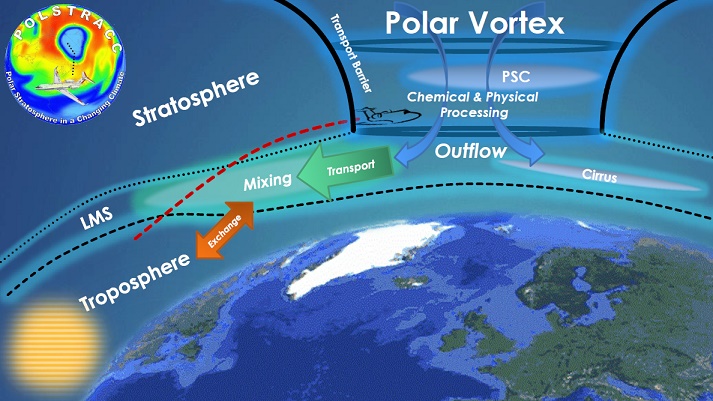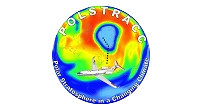Scientific objectives: Difference between revisions
mNo edit summary |
No edit summary |
||
| (47 intermediate revisions by 4 users not shown) | |||
| Line 1: | Line 1: | ||
[[File:POLSTRACC v04 small.jpg]] |
|||
== Key issues adressed by POLSTRACC are: == |
|||
| ⚫ | |||
POLSTRACC aims at improving our understanding of the role of the Arctic stratosphere in the atmospheric system in the future. Utilizing the combination of airborne observations, correlative ground- and satellite-based observations and model simulations, the goal of POLSTRACC is to provide more reliable projections of the development of the upper troposphere and lower stratosphere (UTLS) and in particular the ozone layer in the future. POLSTRACC will employ a high-altitude aircraft campaign during the Arctic winter 2015/16 based in Oberpfaffenhofen (Germany) and Kiruna (Sweden) to study the Arctic polar vortex and its vicininty during an entire winter/spring cycle. The key objectives of POLSTRACC are: |
|||
* Investigating the structure, dynamics and chemical composition of the UTLS at high latitudes, with a special focus on the Lowermost Stratosphere (LMS). Studies on the outflow of the polar vortex and its influence on the composition of the LMS at high and middle latitudes. |
|||
* Improving the understanding of catalytic processes involved in polar ozone depletion, with a focus on chlorine and bromine chemistry in the LMS. |
|||
* Improving the knowledge on polar stratospheric cloud (PSC) composition, de-/nitrification by sedimentation of nitric acid-containing particles and the role of gravity waves or orographic waves on PSC occurrence. |
|||
* Investigating Arctic cirrus clouds, their influence on the radiative forcing and their potential for denitrification, dehydration and chlorine activation. |
|||
The POLSTRACC mission is performed in combination with the BMBF/ROMIC project GW-LCYCLE and the SALSA project, and will involve a modern suite of remote-sensing and in-situ instruments. The POLSTRACC payload covers a variety of trace gases and physical parameters, with contributions from the Karlsruhe Institute of Technology (KIT), Forschungszentrum Jülich (JÜLICH), National Aeronautics and Space Research Centre (DLR), universities and partners. The measurements will be complemented by chemistry transport and climate chemistry modelling studies, allowing to test improved parametrizations of processes involved in chemical ozone depletion, atmospheric dynamics, clouds and the radiation budget of the UTLS. |
|||
* The structure of Arctic LMS: How large are the contributions of (ii) polar vortex air, (ii) extra-vortex stratospheric air and (iii) tropospheric air? |
|||
* The outflow of the polar vortex: How much vortex air descends through the bottom of the polar vortex during the course of the winter? To which extend are the chemical composition and the radiative balance of the surrounding LMS and the adjacent tropopause region affected? How efficient are stratosphere-troposphere exchange processes in the Arctic? |
|||
* Arctic cirrus clouds: To which extend do cirrus clouds around the Arctic tropopause and LMS region disturb chemical budgets (especially ozone) through heterogeneous reactions? Which role do cirrus clouds play in chlorine activation? How are the the budgets of water vapour and reactive nitrogen are affected by dehydration and denitrification through cirrus cloud particles? |
|||
* Polar stratospheric clouds (PSCs): How deep do polar stratospheric clouds penetrate into the lower stratosphere region? How strong is the LMS region disturbed by renitrification of nitric acid trihydrate (NAT) particles? How strong is the linkage between the occurence of PSCs and tropospheric clouds? |
|||
* Gravity waves: How do gravity waves affect the stability of the Arctic polar vortex? |
|||
* Role of the Arctic LMS and tropopause region in climate: How sensitive is the climate to changes in the chemical composition of this region? What are the dominant processes affecting ozone in this vertical range? How will the extent of Arctic cirrus cloud and PSC formation evolve in future and what are the consequences? |
|||
*Monitoring of the spatial and temporal variability of trace constituents, aerosols in the lowermost stratosphere during several phases of the polar winter in a changing climate |
|||
*Providing global models with accurate data from the deployments and to refine their algorithms |
|||
*Investigations whether the models can reproduce the spatial an temporal changes in ozone and relevant trace gases |
|||
| ⚫ | |||
[[Category:One]] |
|||
Latest revision as of 12:47, 20 August 2020

POLSTRACC aims at improving our understanding of the role of the Arctic stratosphere in the atmospheric system in the future. Utilizing the combination of airborne observations, correlative ground- and satellite-based observations and model simulations, the goal of POLSTRACC is to provide more reliable projections of the development of the upper troposphere and lower stratosphere (UTLS) and in particular the ozone layer in the future. POLSTRACC will employ a high-altitude aircraft campaign during the Arctic winter 2015/16 based in Oberpfaffenhofen (Germany) and Kiruna (Sweden) to study the Arctic polar vortex and its vicininty during an entire winter/spring cycle. The key objectives of POLSTRACC are:
- Investigating the structure, dynamics and chemical composition of the UTLS at high latitudes, with a special focus on the Lowermost Stratosphere (LMS). Studies on the outflow of the polar vortex and its influence on the composition of the LMS at high and middle latitudes.
- Improving the understanding of catalytic processes involved in polar ozone depletion, with a focus on chlorine and bromine chemistry in the LMS.
- Improving the knowledge on polar stratospheric cloud (PSC) composition, de-/nitrification by sedimentation of nitric acid-containing particles and the role of gravity waves or orographic waves on PSC occurrence.
- Investigating Arctic cirrus clouds, their influence on the radiative forcing and their potential for denitrification, dehydration and chlorine activation.
The POLSTRACC mission is performed in combination with the BMBF/ROMIC project GW-LCYCLE and the SALSA project, and will involve a modern suite of remote-sensing and in-situ instruments. The POLSTRACC payload covers a variety of trace gases and physical parameters, with contributions from the Karlsruhe Institute of Technology (KIT), Forschungszentrum Jülich (JÜLICH), National Aeronautics and Space Research Centre (DLR), universities and partners. The measurements will be complemented by chemistry transport and climate chemistry modelling studies, allowing to test improved parametrizations of processes involved in chemical ozone depletion, atmospheric dynamics, clouds and the radiation budget of the UTLS.
